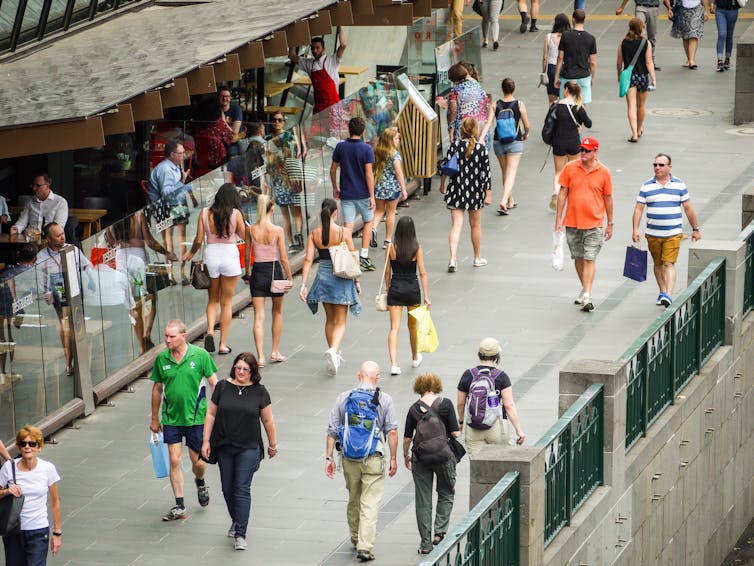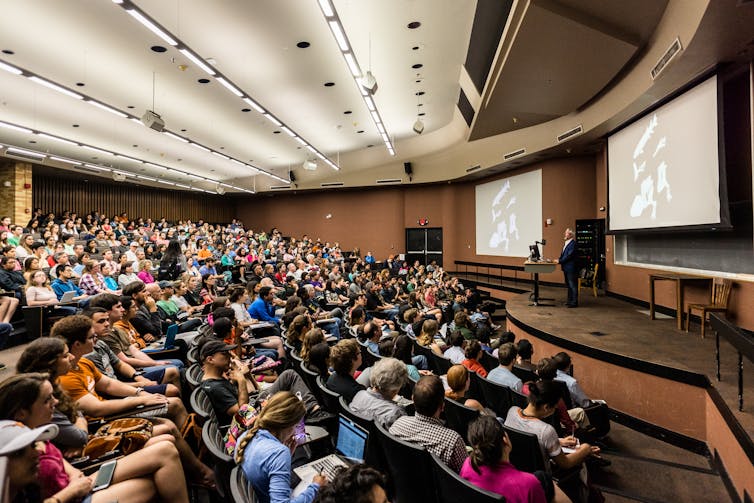Source: The Conversation (Au and NZ) – By Peter McDonald, Honorary Professor of Demography, Centre for Health Policy, The University of Melbourne
Opposition Leader Peter Dutton has suggested the level of Australia’s permanent migration program be reduced from 185,000 – as proposed by the government in the budget – to 145,000. This is a significant reduction.
His rationale is extremely simple: fewer migrants means fewer people needing housing amid a housing crisis.
As tempting as this logic may be, it’s misleading to suggest issues around migration or housing are easy to fix. Far from it.
Instead, these measures could be counterproductive, leaving us with fewer people to fill important skill shortages and ultimately doing little to manage population growth.
Bidding for skills
Under the current system, there are two main streams of migration: family and skilled. Dutton’s announcement has prompted questions about which sorts of migrants would be cut.As the number of new permanent residents in the family stream is dominated by the partners and dependent children of Australian citizens who have a legal right to Australian residence, Dutton’s proposed cut would have to come overwhelmingly from the skilled stream.

Shutterstock
At present, the leading occupations in the skilled stream are nurses, teachers, IT workers and engineers. These are all occupations in high demand. If intake of these professions were cut, employers would need to look for alternative sources of people with these skills. This would be bad news for New Zealand, as Australian state governments would likely target its nurses and teachers.
In addition, state and territory governments would engage in a bidding war for people with these skills. The effect of this would be no decrease in housing demand in the states that won this war and empty houses in the states that lost.
This is not a solution to the housing crisis, which is due mainly to lack of adequate supply.
Also, more than 50% of people granted permanent residence are already living in Australia. Their conversion to permanent residence onshore does not free up housing.
Temporary vs permanent
For the past 18 years, the level of Australia’s permanent migration program has fluctuated in the narrow range of 160,000 to 195,000 under seven different prime ministers, beginning with John Howard. This has proven to be a successful, bipartisan policy, leading to the slowing of population ageing, maintenance of a high employment to population ratio (fewer dependants for each worker), and the provision of skills needed for economic development.
Much of the concern about immigration levels has arisen because net overseas migration, according to the Australian Bureau of Statistics, hit 518,000 in 2022–23. This is an extraordinarily high number by historical standards.
It is not well understood that almost all this net movement (90%) related to temporary residents, not permanent residents. This is important because temporary residents differ in many ways from permanent residents.

Shutterstock
Excluding tourists and New Zealand citizens, there are around 1.7 million temporary residents in Australia. They are not eligible for most government services including Medicare, the Pharmaceutical Benefits Scheme, the National Disability Insurance Scheme, state education, domestic tertiary fees and many more. Temporary residents do not buy houses.
While temporary residents are in the housing rental market, most are mainly in dedicated student or backpacker housing, or live with a higher number of people per dwelling than the permanent population.
The differences between temporary and permanent residents are not taken into account in the calculations made for planning documents such as government budgets and intergenerational reports. It is primarily the permanent population that contributes to economic development and productivity. Planning and understanding would be greatly enhanced if the Bureau of Statistics divided the estimated resident population into permanent and temporary components.
Temporary arrivals in 2022–23 were about 200,000 higher than in 2018–19, the last pre-COVID year. This was due to the COVID-induced backlog of students and working holidaymakers wanting to come to Australia all arriving in the same year, along with the normal annual intake.
Temporary departures were about 100,000 fewer in 2022–23 than in 2028–19 due to an explosion of people switching between visas (known as “visa hopping”) onshore.

Shutterstock
In 2022–23, an astounding 192,000 people on student and graduate visas hopped to the temporary employment visa (408), which gave them an additional two years’ residence. Eligibility for the 408 visa was extended during COVID to provide a means of employment for temporary residents stuck in Australia, but this figure was for the period after COVID.
In March 2024, around 40,000 former working holidaymakers were on the 408 visa or a bridging visa, the first time working holidaymakers have joined the visa-hopping bandwagon. If these visa hoppers had left Australia in 2022–23 rather than visa hopping, the net migration outcome would have been very different.
What about international students?
Both major parties have proposed caps on Australia’s international student intake.
The number of people on student visas in Australia at the end of March 2024 was only marginally higher than the pre-COVID peak. And the present number is high likely because of the backlog of enrolments created by COVID border closures.
Dealing with dodgy educational institutions that exploit international students is important, as is the genuine student test introduced by Labor, but capping numbers attending respectable universities is unnecessary and will likely have negative consequences. There could be staff reductions, the dropping of courses and a reduction in the level of university research.
So what could be done to manage migration more effectively?
The government could start by maintaining the permanent migration program at its 18-year average level. Instead of cutting from the overall intake, severely curtailing visa hopping by accepting fewer visa applications from people already in the country would better manage population growth.
This, combined with leaving international student intake as it is and cracking down on dodgy educational organisations, would be more useful than the current proposals from both major parties.
The Bureau of Statistics should also divide the estimated resident population into permanent and temporary components. This data would help create better migration planning and policy.
![]()
Peter McDonald has received funds from the Australian Research Council related to studies of migration. He has also received funds in the past from the various forms of the Commonwealth Department of Immigration, but not for more than ten years.
– ref. Peter Dutton wants to cut migration for the sake of housing. Here’s why that’s not a good idea – https://theconversation.com/peter-dutton-wants-to-cut-migration-for-the-sake-of-housing-heres-why-thats-not-a-good-idea-230298






